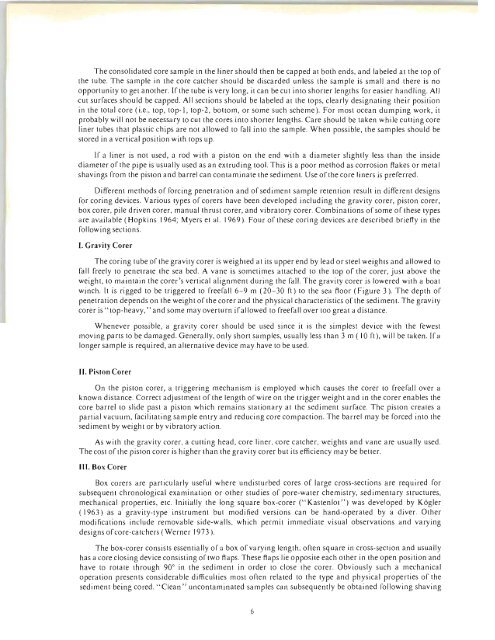You also want an ePaper? Increase the reach of your titles
YUMPU automatically turns print PDFs into web optimized ePapers that Google loves.
The consolidated core sample in the liner should then be capped at both ends, and labeled at the top of<br />
the tube. The sample in the core catcher should be discarded unless the sample is small and there is no<br />
opportunity to get another. If the tube is very long, it can be cut into shorter lengths for easier handling. All<br />
cut surfaces should be capped. All sections should be labeled at the tops, clearly designating their position<br />
in the total core (i.e., top, top-I, top-2, bottom, or some such scheme). For most ocean dumping work, it<br />
probably will not be necessary to cut the cores into shorter lengths. Care should be taken while cutting core<br />
liner tubes that plastic chips are not allowed to fall into the sample. When possible, the <strong>samples</strong> should be<br />
stored in a vertical position with tops up.<br />
If a liner is not used, a rod with a piston on the end with a diameter slightly less than the inside<br />
diameter of the pipe is usually used as an extruding tool. This is a poor method as corrosion flakes or metal<br />
shavings from the piston and barrel can contaminate the sediment. Use of the core liners is preferred.<br />
Different methods of forcing penetration and of sediment sample retention result in different designs<br />
for coring devices. Various types of corers have been developed including the gravity corer, piston corer,<br />
box corer, pile d riven corer, manual thrust corer, and vibratory corer. Combinations of some of these types<br />
are available (Hopkins 1964; Myers et al. 1969). Four of these coring devices are described briefly in the<br />
following sections.<br />
l. Gravity Corer<br />
The coring tube of the gravity corer is weighted at its upper end by lead or steel weights and allowed to<br />
fall freely to penetrate the sea bed. A vane is sometimes attached to the top of the corer, just above the<br />
weight, to maintain the corer's vertical alignment during the fall. The gravity corer is lowered with a boat<br />
winch. It is rigged to be triggered to freefall 6-9 m (20-30 ft) to the sea floor (Figure 3). The depth of<br />
penetration depends on the weight of the corer and the physical characteristics of the sediment. The gravity<br />
corer is" top-heavy," and some may overturn if allowed to freefall over too great a distance.<br />
Whenever possible, a gravity corer should be used since it is the simplest device with the fewest<br />
moving parts to be damaged. Generally, only short <strong>samples</strong>, usually less than 3 m ( 10ft), will be taken. If a<br />
longer sample is required, an alternative device may have to be used.<br />
II. Piston Corer<br />
On the piston corer, a triggering mechanism is employed which causes the corer to freefall over a<br />
known distance. Correct adjustment of the length of wire on the trigger weight and in the corer enables the<br />
core barrel to slide past a piston which remains stationary at the sediment surface. The piston creates a<br />
partial vacuum, facilitating sample entry and reducing core compaction. The barrel may be forced into the<br />
sediment by weight or by vibratory action.<br />
As with the gravity corer, a cutting head, core liner. core catcher, weights and vane are usually used.<br />
The cost of the piston corer is higher than the gravity corer but its efficiency may be beller.<br />
III. Box Corer<br />
Box corers are particularly useful where undisturbed cores of large cross-sections are required for<br />
subsequent chronological examination or other studies of pore-water chemistry, sedimentary structures,<br />
mechanical properties, etc. Initially the long square box-corer ("Kastenlot") was developed by Kogler<br />
( 1963) as a gravity-type instrument but modified versions can be hand-operated by a diver. Other<br />
modifications include removable side-walls, which permit immediate visual observations and varying<br />
designs of core-catchers (Werner 1973 ).<br />
The box-corer consists essentially ofa box of varying length, often square in cross-section and usually<br />
has a core closing device consisting of two flaps. These flaps lie opposite each other in the open position and<br />
have to rotate through 90° in the sediment in order to close the corer. Obviously such a mechanical<br />
operation presents considerable difficulties most often related to the type and physical properties of the<br />
sediment being cored. " Clean" uncontaminated <strong>samples</strong> can subsequently be obtained following shaving<br />
6

















